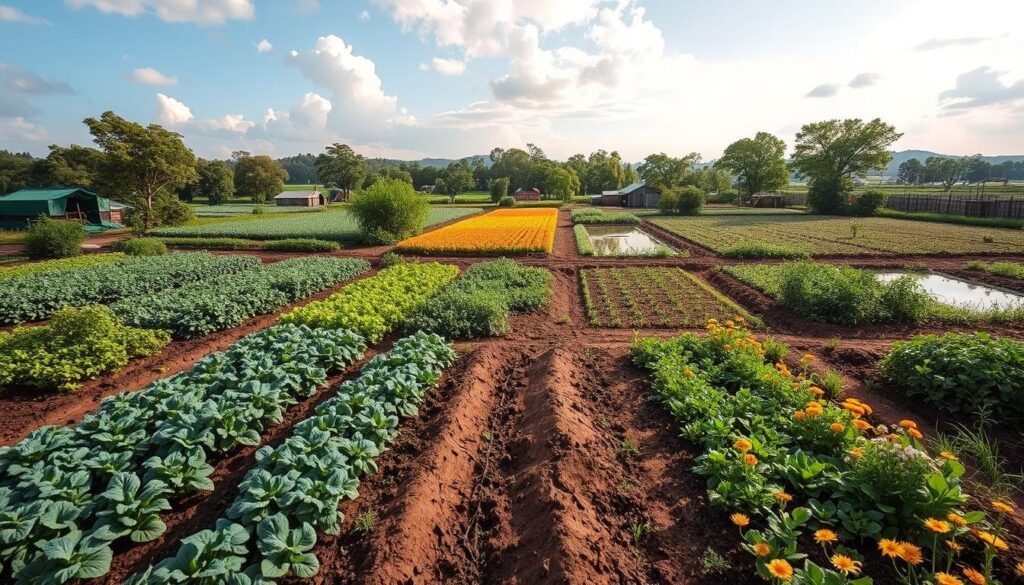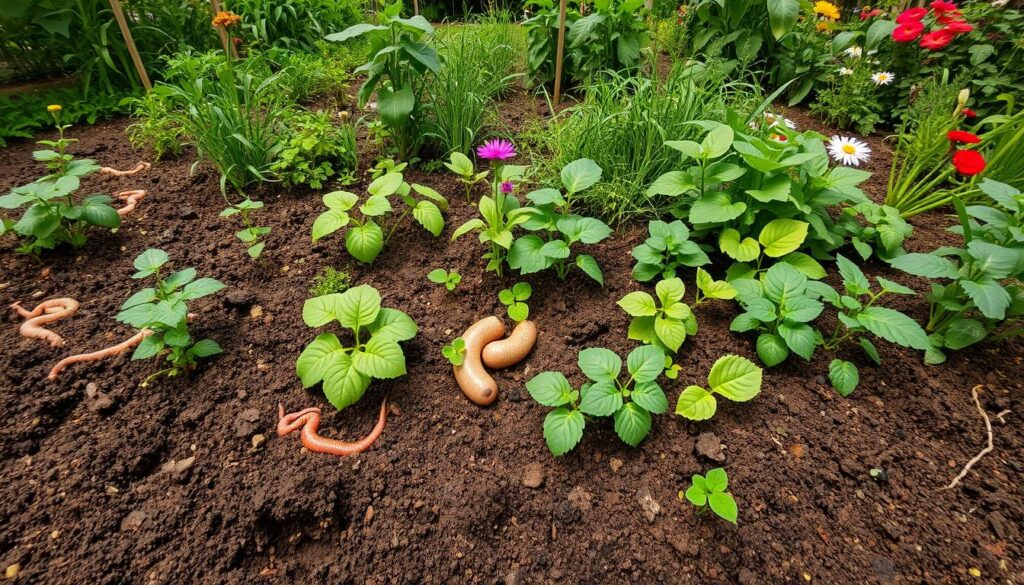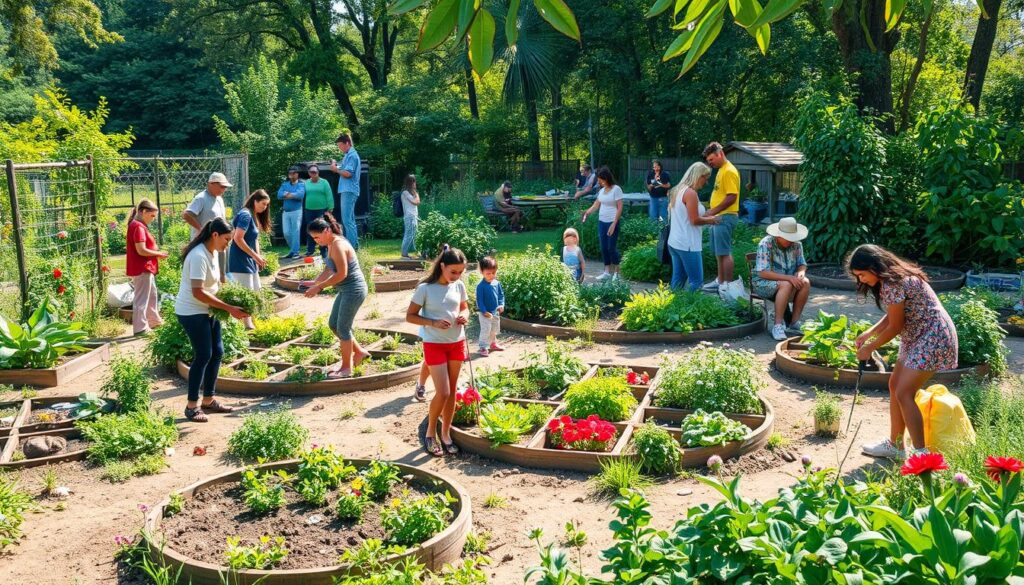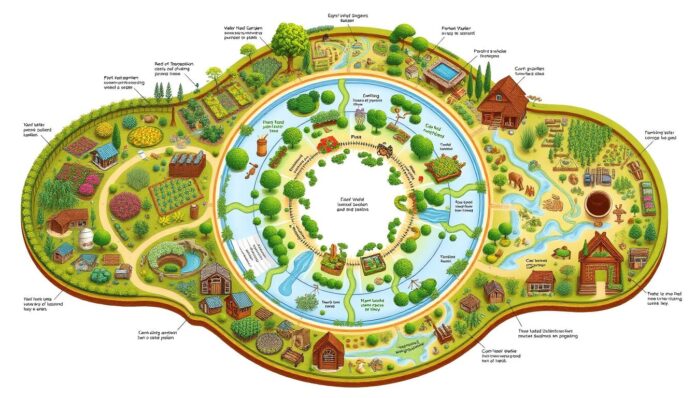Imagine if our gardens and landscapes could be both beautiful and sustainable. This is the heart of permaculture circular design. It blends sustainable landscaping and regenerative agriculture to build thriving ecosystems. The GOBRADIME design process is a key tool, guiding us with 8 steps to create efficient, eco-friendly spaces.
By using permaculture circular design, we can lessen our environmental footprint. We can also boost biodiversity and work towards a greener future. But how do we start? What are the essential parts of a successful permaculture design? How can we apply them in our gardens and landscapes?
Key Takeaways
- Permaculture circular design combines sustainable landscaping and regenerative agriculture to create thriving ecosystems
- The GOBRADIME design process is a key tool for creating efficient and environmentally friendly spaces
- Permaculture circular design can help reduce waste and promote biodiversity
- A well-thought-out design can save time and money, and increase efficiency
- Regular monitoring and maintenance are essential for the ongoing success of a permaculture design
- Permaculture circular design can be applied in a variety of settings, from small gardens to large landscapes
Introduction to Permaculture Circular Design
Permaculture is a way to live sustainably. It was started in 1978 by Bill Mollison and David Holmgren. It focuses on three main ethics: caring for the earth, people, and sharing resources fairly.
Eco-friendly design is central to permaculture. It aims to work with nature, not against it. By following permaculture, we can make systems that are sustainable and give back to nature.
Permaculture can be applied in many areas, like farming and city planning. It helps create systems that are not just sustainable but also grow and improve over time. Benefits include more biodiversity, better soil, and stronger ecosystems.
Definition of Permaculture
Permaculture is a design system for creating sustainable ecosystems. It uses ecology to make systems that work with nature.
Importance of Circular Design in Ecology
Circular design is key in ecology for creating sustainable systems. It helps make systems that waste less and produce more.
| Permaculture Principle | Description |
|---|---|
| Observe and interact | Observe and interact with nature to understand its patterns and rhythms. |
| Catch and store energy | Catch and store energy from the sun, wind, and water to power systems. |
| Use renewable sources | Use renewable sources of energy, such as solar and wind power, to minimize dependence on non-renewable sources. |
Core Principles of Circular Design
Circular design focuses on ecological techniques for environmental sustainability. It aims to use resources wisely and reduce waste. By using regenerative agriculture methods, we can help create a greener future.
Some key principles of circular design include:
- Sustainability: designing systems that can be maintained indefinitely
- Resource efficiency: minimizing waste and optimizing resource use
- Closed-loop systems: designing systems where materials are constantly cycled back into production

By applying these principles in our daily lives, we can greatly help the environment. Using renewable energy, cutting down water use, and recycling are all steps towards a greener lifestyle.
| Principle | Description |
|---|---|
| Sustainability | Designing systems that can be maintained indefinitely |
| Resource Efficiency | Minimizing waste and optimizing resource use |
| Closed-Loop Systems | Designing systems where materials are constantly cycled back into production |
The Role of Biodiversity in Circular Systems
Biodiversity is key in permaculture circular design. It makes ecosystems more resilient and productive. By using many plant and animal species, sustainable landscaping becomes more efficient. This leads to better eco-friendly design solutions.
Some benefits of biodiversity in circular systems include:
- Increased species richness, which can lead to higher ecosystem productivity and resilience
- Improved soil health, through the use of cover crops and other techniques
- Enhanced ecosystem services, such as pollination and pest control
To boost biodiversity in permaculture circular design, try companion planting and polycultures. These methods help create diverse and resilient ecosystems. They support a wider variety of plant and animal species.
The following table highlights the benefits of biodiversity in circular systems:
| Benefit | Description |
|---|---|
| Increased species richness | Higher ecosystem productivity and resilience |
| Improved soil health | Enhanced ecosystem services, such as pollination and pest control |
| Enhanced ecosystem services | Support for a wider range of plant and animal species |
Designing for Water Management
Water management is key in circular design. Techniques like water harvesting and swale creation help save water. In regenerative agriculture, managing water is vital for keeping nature in balance and protecting the environment.
By using methods like rainwater collection and greywater reuse, we can use less municipal water. This reduces our harm to the environment.
Some important ways to manage water include:
- Implementing rainwater harvesting systems to collect and store rainwater for non-potable uses
- Creating swales and ponds to slow down water flow and allow for infiltration and filtration
- Using ecological techniques, such as mulching and cover cropping, to reduce soil erosion and promote water retention
By adding these strategies to our designs, we support sustainable environments and regenerative farming. As we deal with water shortages and environmental damage, focusing on water management is crucial.
A study on the traditional tassa irrigation method showed it boosts productivity by 98% over non-irrigated plots. This shows how vital water management is for ecological and sustainable practices.
| Water Management Technique | Benefits |
|---|---|
| Rainwater Harvesting | Reduces municipal water demand, promotes water conservation |
| Swale Creation | Slows down water flow, allows for infiltration and filtration, promotes ecological balance |
Soil Health and Circular Design
Soil health is key in permaculture, affecting land fertility and productivity. Using holistic design, like composting and cover cropping, boosts soil health. These methods improve soil structure and its ability to hold water, cutting down on the need for outside help.
Permaculture helps make ecosystems more sustainable and strong. For instance, composting kitchen waste and garden clippings gives soil natural nutrients, avoiding synthetic fertilizers. Cover crops also fight soil erosion and boost ecosystem diversity.

- Improved soil fertility and structure
- Increased water-holding capacity
- Reduced need for external inputs
- Increased biodiversity
| Technique | Benefits |
|---|---|
| Composting | Improves soil fertility, reduces waste |
| Cover Cropping | Reduces soil erosion, increases biodiversity |
By using eco-friendly design in their landscapes, people can build sustainable and resilient ecosystems. This follows permaculture and holistic design principles.
Energy Efficiency in Permaculture
Energy efficiency is key in circular design. Techniques like passive solar gain and renewable energy cut down energy use. In permaculture, saving resources is a big deal. Designers use ecological techniques to make systems more efficient and sustainable.
Designing for passive solar gain is a big strategy. Using renewable energy and integrating systems also helps. For instance, regenerative agriculture like agroforestry boosts biodiversity and cuts energy use. These methods help make permaculture systems more efficient and eco-friendly.
Designing for Passive Solar Gain
Passive solar gain means designing to catch and store solar energy. This is done by facing buildings towards the sun, using thermal mass, and adding insulation. These steps help keep the energy in.
Renewable Energy Options
Renewable energy like solar and wind power is a green energy source for permaculture. By adding these to the design, we use less fossil fuels. This makes permaculture systems more energy-efficient.
Applying Circular Design to Food Systems
Using permaculture circular design in food systems cuts down waste and boosts sustainability. It creates systems where materials are reused, needing less outside help. This way, farmers and food makers can lessen their harm to the environment.
Permaculture’s circular design focuses on the whole ecosystem. It designs systems that work well with nature. For instance, garden layouts in permaculture aim to increase biodiversity and cut down waste. Using companion planting can also reduce the need for harmful chemicals.

Permaculture Garden Layouts
Permaculture gardens are set up like natural ecosystems. They mix annual and perennial plants to keep soil healthy and diverse. This approach makes gardens more durable and easier to care for.
Companion Planting Strategies
Companion planting in permaculture helps plants grow better and fights pests. By planting different species together, gardens become more varied and strong. For example, marigolds with tomatoes can keep nematodes away.
Urban Agriculture and Circular Design
Urban farming is crucial for sustainable food systems. Applying permaculture design, urban farmers can make efficient, waste-reducing systems. They use eco-friendly methods like rainwater harvesting and composting to lower their environmental impact.
Waste Management and Recycling in Permaculture
Effective waste management and recycling are key in permaculture. They help the environment and support regenerative agriculture. By using ecological techniques, we can cut down on waste and make a closed-loop system.
For example, composting food scraps can boost garden nutrients. This supports many permaculture principles at once.
Reducing waste in permaculture involves several strategies. Repurposing items for gardening and buying local produce are good starts. Also, sharing extra food in communities can help reduce waste and strengthen bonds.
The Bokashi composting system is another great tool. It turns cooked food waste into a soil enhancer through fermentation.
Using water-wise gardening methods, like buried ollas, can also cut down on water waste. These methods reduce evaporation and runoff. Saving and exchanging seeds also helps preserve biodiversity and cuts down on food waste.
By adopting these strategies, we can make our gardening more sustainable and eco-friendly.
| Waste Reduction Strategy | Benefits |
|---|---|
| Composting food scraps | Enhances garden nutrient levels, reduces waste |
| Repurposing items for gardening | Reduces waste, promotes creativity |
| Buying local produce | Diminishes wasteful packaging, reduces carbon footprint |
Creating a Zero-Waste Garden
Making a zero-waste garden is a big part of permaculture. It’s all about using ecological techniques to reduce waste. By gardening in a circular way, we can make our practice more sustainable and eco-friendly.
Strategies for Community Engagement
Community engagement is key to the success of circular design. Education and collaboration are important strategies to build support. By using permaculture principles, people can make sustainable ecosystems. These ecosystems give us fresh food and help the environment.
This way of holistic design makes people work together. It builds a sense of cooperation and shared responsibility for our planet.
To support eco-friendly design, leaders can hold workshops and seminars. These teach the value of sustainable living and protecting nature. Some ways to engage the community include:
- Starting community projects like gardens or green spaces
- Creating local food networks for small, sustainable farms
- Hosting events to raise awareness and teach about the environment

Together, we can make our communities better. By applying permaculture principles, we can build systems that are good for both the environment and people. This approach to holistic design supports sustainability and strengthens our community. It leads to a more resilient and eco-conscious society.
Economic Aspects of Circular Permaculture
The economic side of circular permaculture is key to its success. Techniques like cost savings and local economies boost sustainability. By using sustainable landscaping practices, people and communities can cut down on waste and save money. For instance, regenerative agriculture can make crops grow better and improve soil health, saving money in the long run.
Here are some ways to get economic benefits from circular permaculture:
- Reducing waste and increasing efficiency in ecological techniques
- Creating local economies and promoting sustainable practices
- Accessing grants and funding opportunities for sustainable projects
By using these strategies, we can help the planet and save money. As more people want sustainable landscaping and regenerative agriculture, the economic perks of circular permaculture will grow.
| Benefits | Description |
|---|---|
| Cost Savings | Reducing waste and increasing efficiency in ecological techniques |
| Local Economies | Creating local economies and promoting sustainable practices |
| Grants and Funding | Accessing grants and funding opportunities for sustainable projects |
Monitoring and Evaluation of Circular Systems
Monitoring and evaluating circular systems is key to their success. It’s about tracking important things like energy use, water, and waste. This helps see how well the system is doing. By using circular economy frameworks, we can spot where to get better and make smart choices.
Looking at the whole system is important. This means thinking about social, economic, and environmental parts. It helps us make plans that can change as needed to keep the system going strong.
- Implementing closed-loop systems to minimize waste and reduce the need for external inputs
- Using renewable energy sources, such as solar or wind power, to reduce reliance on non-renewable energy
- Creating diverse and resilient ecosystems to promote biodiversity and ecosystem services
By using these strategies, we can make a system that’s good for the planet and people.
| Strategy | Description |
|---|---|
| Key Performance Indicators | Tracking energy efficiency, water usage, and waste reduction |
| Community Feedback Mechanisms | Engaging with the community to gather feedback and identify areas for improvement |
| Adaptive Management Strategies | Adjusting the system as needed to ensure long-term sustainability |
Case Studies: Successful Permaculture Circular Designs
Regenerative agriculture and ecological techniques are key for a sustainable environment. Many case studies show the success of permaculture designs. For example, the Bec-Hellouin Farm in France is a standout. It works on nearly 50 acres and produces ten times more than traditional organic farming.
Some notable examples of successful permaculture circular designs include:
- The Bec-Hellouin Farm, which grows a wide variety of produce on just 0.9 acres. It supplies up to 100 vegetable boxes a week to locals and fancy restaurants.
- The Permaculture Literacy Program in the Philippines, which teaches and certifies people in permaculture. It helps build a community that supports sustainable farming.
These examples show how permaculture designs can make farming more sustainable and productive. By using ecological techniques and designing systems that work like nature, we can improve farming. This leads to better food and a healthier planet.
| Case Study | Location | Key Features |
|---|---|---|
| Bec-Hellouin Farm | France | High-yield production, diverse crop cultivation, local food supply |
| Permaculture Literacy Program | Philippines | Education and certification, community engagement, sustainable farming practices |
Future Trends in Permaculture Circular Design
The world is moving towards permaculture principles and holistic design. This is good news for eco-friendly design. New technologies and methods are coming up to tackle climate change.
Policymakers are now seeing the value of circular design. It can make our communities more sustainable and strong. This is a big step towards a better future.
Things like using biomass and renewable energy are becoming more common. Companies are working towards zero waste and using resources better. This shift to a low-carbon economy is led by permaculture’s sustainable approach.
Looking ahead, we need to keep improving eco-friendly design and using holistic strategies. These steps are key to facing climate change. By following permaculture and circular design, we can build a lasting, green future.

